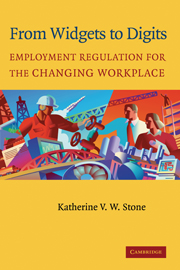Book contents
- Frontmatter
- Contents
- Preface
- Introduction
- PART I LABOR RELATIONS REGIMES OF THE PAST
- 1 Artisanal Production in the Nineteenth Century
- 2 The Labor System of the Industrial Era
- 3 From Scientific Management to Internal Labor Markets
- PART II THE DIGITAL WORKPLACE
- PART III IMPLICATIONS OF DIGITAL JOB STRUCTURES FOR LABOR AND EMPLOYMENT LAW
- PART IV SOCIAL JUSTICE IN THE DIGITAL ERA
- Summary and Conclusion
- Index
3 - From Scientific Management to Internal Labor Markets
Published online by Cambridge University Press: 14 January 2010
- Frontmatter
- Contents
- Preface
- Introduction
- PART I LABOR RELATIONS REGIMES OF THE PAST
- 1 Artisanal Production in the Nineteenth Century
- 2 The Labor System of the Industrial Era
- 3 From Scientific Management to Internal Labor Markets
- PART II THE DIGITAL WORKPLACE
- PART III IMPLICATIONS OF DIGITAL JOB STRUCTURES FOR LABOR AND EMPLOYMENT LAW
- PART IV SOCIAL JUSTICE IN THE DIGITAL ERA
- Summary and Conclusion
- Index
Summary
The job structures that emerged as a result of Taylorism and the personnel management movement deviated in several respects from the way the labor market was predicted to work by neoclassical economic theory. In the labor market of neoclassical theory, workers are assumed to move freely between firms and jobs, constantly seeking and seizing new opportunities to maximize their incomes. Firms likewise hire and dismiss workers freely as demand for their products fluctuates. Firms also raise and lower wages to correspond to changes in product and labor market conditions, all the while paying their employees the value of their marginal product at every point in time. In the theory, wage differentials for any given skill level between firms and within firms disappear over time as wages achieve an equilibrium level. At equilibrium, each worker is paid the prevailing market wage for his or her skill level, each employer has equal labor costs, and the amount of labor hired by any particular firm is determined by the demand for its product and its level of technological and administrative prowess.
In the 1940s and 1950s, a group of labor economists studied the operation of the labor market and found that it did not operate according to the predictions of the neoclassical theory. John Dunlop, Clark Kerr, Lloyd Reynolds, Richard Lester, and others became familiar with the actual operation of labor markets by working for the National War Labor Board. Subsequently, they conducted empirical studies of local labor markets from which they concluded it was necessary to revise neoclassical labor market theory.
- Type
- Chapter
- Information
- From Widgets to DigitsEmployment Regulation for the Changing Workplace, pp. 51 - 64Publisher: Cambridge University PressPrint publication year: 2004

